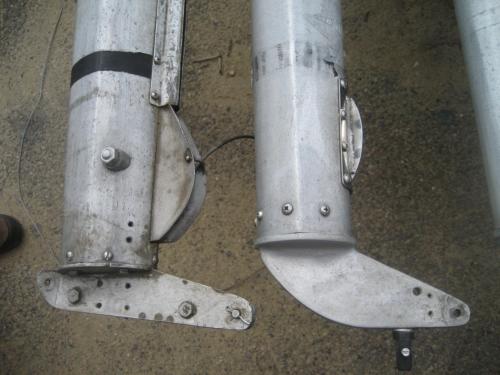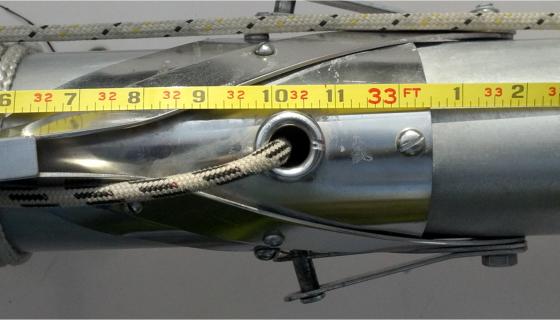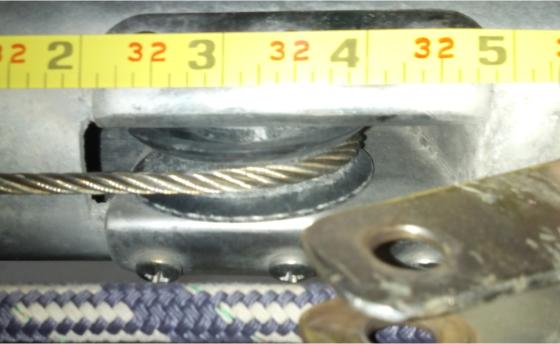
Measurer’s Interpretations and Recommendations
| Topic: | Mast |
|---|---|
| Question: | The mast is currently being produced at 39' 4-5/8" but the specifications are 39' 6"? |
| ID Number: | 000037 |
| Date: | 2011-07-29 |
| Short Answer: | |
| Answer: | Cape Cod Shipbuilding indicates: After some research we determined that Chris Craft Corp. changed the mast head casting once they started building the Shields. In order to assure the overall mast length did not change, Chris Craft changed the extrusion cut length from 39' 6" to 39' 4 5/8". It appears as if the bluebook dimension still displays the old extrusion measurement. Once the molds/plans came back to Cape Cod Shipbuilding from Hinckley we continued to build all masts to the same cut length of 39' 4 5/8. |
| Section: | Official Plan 2 - Fittings and Rigging |
| Image: |
 |
| Status: | Affirmed |
| Action Date: | 2012-02-07 |
| Date | Name | Comment |
|---|---|---|
| 2011-08-04 | Richard Robbins | Out of the masts that were here at CCSB - they had the following deck height to top of extrusion dimensions (excluding mast head casting) (Official Plan - 2 indicates 36' 6-5/8") 36' 4 1/2" 36' 5 1/4" 36' 5 1/2" 36' 7" 36' 8" This variation has to do with varying mast step supports and varying deck reinforcements. Some step supports disintegrate so the masts sit lower and some decks are not reinforced so they bow when the rig is under tension. |
| 2011-08-08 | Cape Cod Shipbuilding | When someone orders a new mast, we install everything in the same position measuring from the butt of the mast up (spreader bases, sheave boxes, shroud tangs, spin track etc). The one item we can't install is the fixed gooseneck plate. We will supply that loose as it's location will vary depending on the mast step & deck height. It's a pain, as owners need to step their mast & tune the rig before determining the fixed gooseneck plate location. The only hardware location that varies on the Shields mast is the fixed gooseneck. On older boats, they used to have a gooseneck slide, so the black band rule really was in place to prevent folks from moving their gooseneck slides down. |
| 2011-11-09 | Kim Roberts | The mast should be constructed from the top down and the butt cut to match the mast bury and the 2' 5" deck to black band.This would assure that the jib, spinnaker and mainsail loft are all correct and equal. |
| 2011-11-09 | Richard Robbins | I would also propose that we use the current design mast bury (35.1875" with a tolerance of +/- 1/2") and write this into the Rules and have it apply to new boats (which should not be a problem) and whenever a mast step is relocated. The current Rules do not mention a mast bury. From the 2004 survey, the proposed specification would have 22 out of 37 yachts within the range. I would propose no action required of existing yachts. |
| 2011-11-14 | Kristian Martincic | The curious thing about mast lengths here is that height of the mainsail and jib aren't affected. The hight of the main is governed by the black band, and the jibs are well short of full hoist. The spin halyard exit is the only sail that really differs between boats of different buries and the same length mast. |
| 2011-11-15 | Richard Robbins | Spinnaker fairlead measured from butt on #239. Offical Plan 2 indicates 29' 10-5/8" from deck. Adding 35-3/16" mast bury is 32' 9-13/16".
|
| 2011-11-15 | Richard Robbins | Jib sheave measured to butt on #238. Offical Plan 2 indicates 29' 3-3/4" from deck. Adding 35-3/16" mast bury is 32' 2-15/16". |
| 2011-12-03 | Cape Cod Shipbuilding | There are usually a few ways to accomplish any particular task. All methods work, but some craftsman prefer one method over another for familiarity sake, or to make it simple/fool proof. All spar manufacturers, including our shop take measurements from the butt or bottom of the mast, then install the hardware. When you build a house, you don't measure from the roof or the walls down, you measure from the foundation-up. Over the last 60 years of aluminum spar construction, the hooking of a steel tape measure on the end of the tube and measuring up the mast is more accurate than using masking tape to hold the end of a tape measure at a prescribed mark (black band) on the aluminum tube. Yes, for the class measurer when the mast is vertical in the boat, the bottom of the tube is inaccessible, due the collar and mast wedge etc. To the spar builder/machinist the tube is horizontal on the bench in vices so the end of the tube is most accessible. The issues that are raised if we supply masts that are 2" longer: 1. The 2 lower exit boxes are too close to the butt to install & then cut the tube-they would have to be installed after the butt is cut. 2. Not all boatyards have horizontal metal cutting band saws, so the cut would have to be done in our shop before shipping/pick up. Some fleets have a stock mast at their local boat yard for quick replacement. 3. Some masts are sold second hand & the masts would no longer be able to be transferred from boat to boat 4. When the mast is manufactured, we taper the top, cut the butt, mill the sail-feed & exit boxes & then install the hardware. If an error is made during the cutting/milling process & we have to scrap the tube, we are only out the cost of the tube & the time to taper. If an error is made in the cutting after the hardware is installed the loss is much greater. 5. There are possibilities that owners would measure incorrectly & a cut could be made that sets the mast height out of compliance. Measurements from the step to the deck on older boats are different when the rig is stepped & under tension as opposed to when the deck is at rest without tension. 6. If a mast is needed in a hurry for replacement at a regatta, determining the step to deck measurement & then cutting the butt will delay the process. 7. Owners could quite possibly not cut the tube to length & therefore raise the rig higher than the other 250 existing shields. 8. In order to be profitable, we try to make the spars in groups or runs. We would much prefer to not change this process & have to build individual spars for individual boats as this will raise the costs considerably. Surprisingly when we send out replacement shrouds they very rarely are returned as to a length problem. Masts step heights are quite uniform except for the first 20 boats built. (And 5 of these boats have been burned beyond use.) This issue only concerns a very small minority. The low number boats that we have here in our care, or have been at one time in our shop (2,5,6 & 8) we have successfully built up the mast step supports so a standard mast fit each of these boats. We recommend keeping all the masts uniform & working to assure the mast steps become uniform. This means installing spacers under the mast step casting of boats 1-20 so the mast heights are all the same. |
| 2011-12-09 | Richard Robbins | Based on input from CCSB the Techncial Committee agrees that the mast will continue to be built in a standard length and dimensioned from the butt with the gooseneck set when married to the boat to achieve the 2' 5" to the deck. It was pointed out that the deck does move when the rig is under tension and the gooseneck dimension should be measured with rig tuned. Official Plan 2 will be updated to reflect the changes in the extrusion length and the fact that certain dimensions to the deck depend on the mast bury. |
| 2012-02-09 | Richard Robbins | Governing Board meeting of 2/7/2012 affirmed the changes to Official Plan 2. |